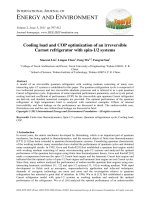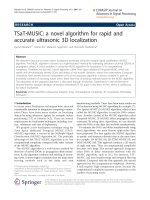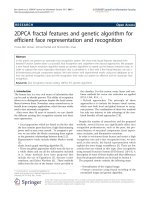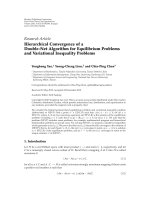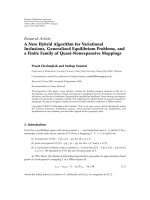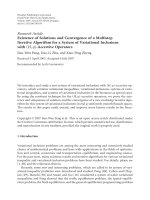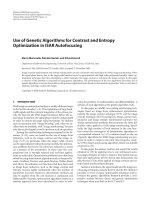A modified genetic algorithm for time and cost optimization of an additive manufacturing single-machine scheduling
Bạn đang xem bản rút gọn của tài liệu. Xem và tải ngay bản đầy đủ của tài liệu tại đây (521.53 KB, 16 trang )
International Journal of Industrial Engineering Computations 9 (2018) 423–438
Contents lists available at GrowingScience
International Journal of Industrial Engineering Computations
homepage: www.GrowingScience.com/ijiec
A modified genetic algorithm for time and cost optimization of an additive
manufacturing single-machine scheduling
M. Feraa*, F. Fruggierob, A. Lambiasec, R. Macchiarolia and V. Todiscoc
aDepartment
of Industrial and Information Engineering, University of Campania “Luigi Vanvitelli”, Via Roma 29, Aversa, CE, Italy
of Basilicata, School of Engineering, Via Nazario Sauro, 85, Potenza, PZ, Italy
cDepartment of Industrial Engineering, University of Salerno, Via Giovanni Paolo II, Fisciano, SA, Italy
CHRONICLE
ABSTRACT
bUniversity
Article history:
Received October 20 2017
Received in Revised Format
December 25 2017
Accepted January 14 2018
Available online
January 16 2018
Keywords:
Additive Manufacturing
Scheduling
Time
Cost
Metaheuristics
Production Planning
Additive Manufacturing (AM) is a process of joining materials to make objects from 3D model
data, usually layer by layer, as opposed to subtractive manufacturing methodologies. Selective
Laser Melting, commercially known as Direct Metal Laser Sintering (DMLS®), is the most
diffused additive process in today’s manufacturing industry. Introduction of a DMLS® machine
in a production department has remarkable effects not only on industrial design but also on
production planning, for example, on machine scheduling. Scheduling for a traditional single
machine can employ consolidated models. Scheduling of an AM machine presents new issues
because it must consider the capability of producing different geometries, simultaneously. The
aim of this paper is to provide a mathematical model for an AM/SLM machine scheduling. The
complexity of the model is NP-HARD, so possible solutions must be found by metaheuristic
algorithms, e.g., Genetic Algorithms. Genetic Algorithms solve sequential optimization
problems by handling vectors; in the present paper, we must modify them to handle a matrix.
The effectiveness of the proposed algorithms will be tested on a test case formed by a 30 Part
Number production plan with a high variability in complexity, distinct due dates and low
production volumes.
© 2018 Growing Science Ltd. All rights reserved
1. Introduction
Additive Manufacturing (AM) is a topic that is experiencing a continuous enlargement. In fact, it collects
an increasing number of researches year by year and covers several research areas, from the design of
the products and material investigations to manufacturing issues. This paper aims to analyze how to
schedule production orders for a single AM (DMLS®) machine by considering a time and cost
optimization framework. The purpose is to find a mathematical model that is useful for production
planners who must schedule an AM production that is both time- and cost-efficient, perfectly in line with
Lean Manufacturing principles.
Section 2 presents a formalization of the problem that will be studied in this paper. Section 3 presents a
brief literature review about AM in an actual specified research field: production planning. The literature
* Corresponding author
E-mail: (M. Fera)
2018 Growing Science Ltd.
doi: 10.5267/j.ijiec.2018.1.001
424
is systematically reviewed, but not all suggestions seem to be aligned with the actual needs of the
industrial sector for a single-machine AM machine Scheduling Problem (AMSP). Section 4 presents the
model formulation for AMSP, with a multi-objective function (OF) that is subject to constraints on the
geometrical volume of the parts to be produced and on other production variables. In this section, the OF
combinatorial Optimization Problem (MOP) is divided into time and cost parts, each one is represented
in detail, and the computational complexity for AMSP is demonstrated to be NP-HARD. Next, Section
5 provides a solution to AMSP using a traditional metaheuristic algorithm like Genetic Algorithms
(GAs). It is worth noting that this algorithm alone cannot provide a solution to AMSP. The GA needs
some changes to operate over the proposed mathematical model. A GA based on a 2D crossover will be
presented in details. In Section 6, a test case for checking the effectiveness of the proposed algorithm is
presented, by considering time and cost reduction, and also the running time. In Section 7, new ideas for
future improvements and researches are proposed.
2. Open issue/scheduling problem analysis
A traditional scheduling problem is defined as follows:
“Given a set of jobs
, , , … and a set of machines
, , , … , assign job to resources
to optimize (minimize/maximize) an objective (certain goal).”
The production systems that satisfy the demands for orders or for the stocks generally produce parts
dividing the demand in smaller parts, which are defined as batches of a specific part number (PN). When
we need to pass from a PN to another, a change is needed. Batch quantity is accurately chosen to minimize
the setup number during the production, since this is an activity without added value.
Gantt
J1
J2
J3
J4
J5
….
Time
Fig. 1. Traditional schedule shape
The scheduling problems are commonly represented using a Gantt diagram (Fig. 1), which shows how a
single-machine scheduling problem becomes a sequential optimization problem, where sequence is a
vector of jobs. In fact, the goal is to find the best combination of jobs on the machine to optimize a certain
objective: lateness, tardiness, flow time, number of late job, make span, etc.
Process sequence in computational terms is a vector resumed as follows:
, , , … →
1, 2, 3 … .
The aim of traditional single-machine scheduling is to find the best combination of quantities to be
produced in advance, i.e., jobs.
Scheduling principles change in case of AM machines. A generic j-th job can be constituted by several
geometries. The job is now heterogeneous in AM, i.e., the single production run can involve several PNs
and not only one like in traditional machines. This news can be summarized as follows. Let us denote
“build” as a set of several traditional jobs that can be identified as the couple constituted by G and n,
where G identifies the geometry type to be produced and n is the number of parts to be produced for the
j-th production run called build.
↔
,
,
,
,
,
,…,
,
.
425
M. Fera et al. / International Journal of Industrial Engineering Computations 9 (2018)
Job is a heterogeneous concept in AM, corresponding with build chamber composition, usually known
synthetically as build. To point out this latter concept, we can propose a figure by Baumers.
A build is made up of various PNs/Geometries to produce each one with its independent number , , as
it is possible to see from a representation of a generic build for an AM machine.
Fig. 2. Build concept
,
,…,
.
It is worth noting that there is a possibility that a single build could not satisfy the overall demand, so the
planner must divide production in several builds. Index j for the builds goes from 1 to , i.e., the required
number of build needed to complete production. Therefore, the AM machine schedule form is a set of
builds, i.e., a matrix, as shown in Table 1.
The AM scheduling problem is summarized in the following research questions:
1. What is the number of each geometry/PN for each build?
2. How many builds are necessary to complete production?
The research questions for AM are different from the ones for SM. To introduce the research questions
on AM scheduling, literature review is presented, which will review internationally published papers on
single-machine scheduling, AM or SM, with similarities to the research questions previously introduced.
Table 1
AM schedule model shape
Build
S
1
2
3
…
nb
1
n1,1
n1,2
n1,3
…
nnb,1
2
n2,1
n2,2
n2,3
…
nnb,1
Geometries
3
n3,1
n3,2
n3,3
…
nnb,3
…
…
…
…
…
…
ng
ng,1
ng,2
ng,3
…
nnb,ng
3. Literature review
In the last 20 years, papers about AM have been increased systematically. According to Witherell et al.
(2017), Costabile et al. (2017), Fera et al. (2016a), and Fera et al. (2017), this is a multi-disciplinary topic
because it links together design, material science, energy consumptions, life cycle management, laser
technology, computer science, supply chain management, and production planning. The importance of
the AM research field of management is witnessed also by Pour et al. (2016), who presented a set of
proposals to reconfigure the production system and supply chain to enable AM as a reliable and
functional system. The importance of the AM is also witnessed by the use of this technology in terms of
the interaction between the machines and the humans as underlined by Fruggiero et al., 2016 and the use
426
of this new technology in terms of CO2 emissions reduction during the life span as underlined by Fera et
al. (2016b). The importance of the AM in the production context is witnessed also by the fact that this
technology is one of the enabling technologies for the achievement of the Industry 4.0 paradigms
(Dilberoglu et al., 2017; Fruggiero et al., 2016).
Over the years, several papers on all of the above research fields have been published, but very few seem
to consider an AM machine in the production department context, maybe because the first studies were
devoted more to understanding the capability of this new technology, especially using metals instead of
plastic powders. This paper aims to analyze how to schedule production orders for an AM (DMLS®)
machine to achieve time and cost optimization.
A systematic literature review was made to discover possible sources for the proposed paper goal, i.e.,
AM scheduling problem. Unfortunately, the sources are not so many, but few of them are, however,
present in the cited databases. The theme of the process planning using AM is known as a research theme
since 2008 (Ren et al., 2008), but it was not developed for the reasons about the reliability of the
production process in terms of mechanical properties of the metal products.
The first source is Li et al. (2017), a work about production planning of distributed AM machines to fulfil
demands received from individual customers in low quantities. The aim of the paper is to understand
how to group the given parts from different customers and how to allocate them to various machines to
minimize average production cost per volume of raw material. The authors recognized that the problem
is not resolvable in acceptable time by a normal CPU, so they preferred to create two different heuristics.
The heuristics take into account the fact that AM machines are different, located in several parts of the
globe, and two main data for the products to be realized are available, i.e., maximum part height and
production area of the machine. It is worth noting that this is a good way to optimize the problem, but it
neglects the important fact that, sometimes with support structures, the machine chamber allows a part
on top of each other. Moreover, the aim of this paper is to investigate the scheduling of a single machine
in a specific production system, not in a geographically distributed environment, so that the paper can
give some advice on the problem, such as the complexity and the mathematical model, but it is a different
problem from the one discussed in this paper.
Ransikarbum et al. (2017) proposed a decision support model based on a multi-objective optimization
for orientation of a batch of parts and multiple printers, given fixed, un-rotated orientation of parts. A
model that considers operating cost, load balance among printers, total tardiness, and total number of
unprinted parts as objectives in the fused deposition modelling process is provided. Even if this model is
close to the answer to our research question, for the fact that it refers to a multi-printer distributed
environment, it does not fulfil the objective of the present research. Jin et al. (2017) focused their attention
on the process planning theme using AM. The research dealt with the definition of a process planning to
minimize the raw material consumption for the AM. Another interesting work about the assignment of a
specific job to a build was presented by Zhang et al. (2016). This work focused on how to optimally place
multi-parts onto the machine build platform or in build space with respect to user-defined objectives. The
authors presented this problem as an NP-HARD 3D space problem, being a variant of nesting or
packaging problem in 2D. The method is based on a two-step algorithm: the first step is to choose the
part’s orientation, and the second step defines the assignment of the part with an orientation to a specific
build. Other sources available on related research themes close to the one investigated in this paper are
about the use of the process planning techniques for the re-working processes using AM or combining
AM with the subtractive technologies. Zu et al. (2017), starting from a framework defined by Newman
et al. (2015) investigated specifically this research theme by defining a new decision support model to
combine the old and the new production technologies in terms of process planning with the objective to
optimize the modification process of existing products.
427
M. Fera et al. / International Journal of Industrial Engineering Computations 9 (2018)
As it is possible to see from the previous literature review, the valuable sources are not really focused on
the research theme, purpose of this paper. To summarize, all reviewed models tried to consider AM
machines in the production planning context, also in interaction with the traditional production machines,
but no details on single-machine scheduling were presented. The main part of the sources was on the
process planning and not on the scheduling of the single AM machine. Specifically, there are no answers
to our two research questions at the end of Section 2. Therefore, the research questions in this paper are
open issues in the research field introduced so far.
4. Model formulation
As introduced so far, AM scheduling is a problem to be solved since this technology started to be a
permanent part of the production environment of several companies, especially in the fields of defense
and aerospace. The question that the paper wants to answer is always the same for all scheduling
problems, i.e.:
“What’s the schedule that allows to respect due dates with the least production cost?”
The question is the same, but the context as explained in the Introduction is very different from the
traditional ones for the motivations illustrated in the previous paragraphs. Therefore, let us introduce a
multi-objective model for the AM scheduling that is able to consider also the new constraints given by
the new context. This type of model in literature is known as Multi-Objective Optimization Problem
(MOP) because it presents double objectives: time and cost.
In our vision (Fig. 3), Production orders are the inputs of the AMSP; the attributes of an order are
Fig. 3. Mathematical model frame
:
:
:
demandof
geometryorPN
duedateof
geometryorPN
volumeof
geometryorPN
.
After that the attributes for the production orders are listed, it is worth noting that, in this paper, a Time
& Cost model will be applied. In particular, the Completion Time (CT) and the Total Part Cost (TPC)
will be considered. CT is the time to produce a single unit of
geometry, whereas TPC is the costs
to be covered to produce a single part, and it is possible to compute itself using the method illustrated in
Fera et al. (2017). Once the main description elements of our model are described, let us introduce the
mathematical formulation of the optimization problem analyzed here. The basic model is taken from a
research paper that used earliness and tardiness as objective functions (Nearchou, 2010); in this proposal,
cost is added.
where
428
subject to:
,
∗
∀ ∈ 1,
,
,
∀ ∈ 1,
,
,
,
, ,
∈
, , , ,
,
,
∈
.
The proposed scheduling model has some hypotheses that are listed below:
The scheduling problem faced here is a Single-machine scheduling problem, where the machine
is an AM machine: DMLS® or SLM process based.
The part orientation is given, and the required space for manual part removal is presented.
The build chamber allows construction of parts on top of each other by support structures or other
solutions.
Stock costs are neglected.
4.1. Objective function
Let us start to explain the completion time part of the objective function. The due date respect is the first
goal to achieve. Production planning must balance earliness and tardiness, two concepts summed up by
the term lateness.
0,
,
, 0 .
is the due date of – order.
In the previous equations, is the completion time, and
Earliness must be compressed to reduce inventory costs as stated in the JIT and Lean Manufacturing
theory. Tardiness must be minimized to avoid monetary or strategic penalties. Starting from these wellknown facets, it is possible to estimate the tardiness damages as a monetary penalty proportional to each
day of delay, and strategic damage will be neglected in this study because of the difficulty in evaluating
and estimating it.
A common way to model the E&T problem is
1||
where
:
:
Earliness of –
job
Tardiness of j–th job
number of job
#
429
M. Fera et al. / International Journal of Industrial Engineering Computations 9 (2018)
:
constant weigh for E
:
constant weigh for T
1⁄
1⁄
,
are constant weights computed as follows:
1
1
,
.
max
min
min
max
An important concept to underline is that, in AM, E&T of the completion time of an order is not related
to the processing time on the same order (geometry). In fact, a single order can be divided into a certain
number of builds, each of them with an own geometrical mix; this means that, with AM, different jobs
can be performed simultaneously, achieving the number of parts due to the client in parallel with others.
The classical problem of set-up is represented in a very different way, since the raw material should be
ready for all of the geometries to be built or for the preparation of the building program on the machine,
but all the times to change production related for example to the tools change are no more present.
The completion time of an order binds itself to the processing time of each build in which it is divided.
To clarify this concept, please check the example in Table 2.
Table 2
Example of job division between different buildings
Geometries
S
Build
1
2
3
4
DDi [day]
1
7
1
0
0
25
2
3
0
4
0
30
Cj
3
2
1
0
0
26
4
0
1
0
1
11
18
26
34
39
In Table 2, order #2 is clustered in
and
, and it will have a completion time of 34 days,
with 4 days of tardiness. Therefore, we propose a new version of the E&T equation used in the AM
context:
,
where
:
:
:
,
:
,
,0
,0
Earliness of – order
Tardiness of – order
due date of – order
completion time of – build, the last in which i–thorder has been divided.
It is worth noting that the difference between the clustering of the production order in different builds is
very different from the one proposed in the past, when the order was clustered focusing on the number
of set-up minimization. Therefore, in the past, clustering focused on minimizing the completion time, but
maximizing the number of objects processed in a single job on the machine. Now, the objective is always
the same, but the number of objects for a single build does not have to be the maximum possible with
respect to the delivery dates, but the maximum that can be hosted in the build camera volume, to optimize
the volume saturation of the camera, which is recognized as a key factor for AM machine optimization
(Fera et al., 2017). The E&T objective function in the case of the AMSP is modified as follows:
430
where
:
1⁄
1⁄
Earliness constant weight
:
Tardiness constant weight
:
Earliness of –
:
Tardiness of – order
number of order/geometries
:
order
Time part of proposed MOP
:
,
are constant weights related to – schedule and they are computed as follows:
1
1
,
.
min
max
����������������������������������������������������������������������������������������������������������������������������������������������������������������������������������������������������������������������������������������������������������������������������������������������������������������������������������������������������������������������������������������������������������������������������������������������������������������������������������������������������������������������������������������������������������������������������������������������������������������������������������������������������������������������������������������������������������������������������������������������������������������������������������������������������������������������������������������������������������������������������������������������������������������������������������������������������������������������������������������������������������������������������������������������������������������������������������������������������������������������������������������������������������������������������������������������������������������������������������������������������������������������������������������������������������������������������������������������������������������������������������������������������������������������������������������������������������������������������������������������������������������������������������������������������������������������������������������������������������������������������������������������������������������������������������������������������������������������������������������������������������������������������������������������������������������������������������������������������������������������������������������������������������������������������������������������������������������������������������������������������������������������������������������������������������������������������������������������������������������������������������������������������������������������������������������������������������������������������������������������������������������������������������������������������������������������������������������������������������������������������������������������������������������������������������������������������������������������������������������������������������������������������������������������������������������������������������������������������������������������������������������������������������������������������������������������������������������������������������������������������������������������������������������������������������������������������������������������������������������������������������������������������������������������������������������������������������������������������������������������������������������������������������������������������������������������������������������������������������������������������������������������������������������������������������������������������������������������������������������������������������������������������������������������������������������������������������������������������������������������������������������������������������������������������������������������������������������������������������������������������������������������������������������������������������������������������������������������������������������������������������������������������������������������������������������������������������������������������������������������������������������������������������������������������������������������������������������������������������������������������������������������������������������������������������������������������������������������������������������������������������������������������������������������������������������������������������������������������������������������������������������������������������������������������������������������������������������������������������������������������������������lized in the time execution for the specific part, the C factor is introduced.
This element must be a-dimensional and comparable to the time part. To achieve the objectives of
summability and comparability, an algorithm for finding the proper weight for the AM cost is proposed.
The desired weight must make a-dimensional C but on the same order of magnitude as .
~ 10
~ 10
.
To gain either of the goals, as anticipated before, a small algorithm that will be inside the general
optimization procedure is presented as follows:
order of magnitude, indicated as .
a. Find
b. Compute C as sum: ∑
.
c. Find
order of magnitude, indicated as .
d. Compute order of magnitude
using the following equation:
10
10
→
k
k .
10
Now, compute weight :
432
1
.
10
Finally, the MOP Cost Part has the following weighted formulation:
.
4.2 Model constraints
The first constraint presented in the model in the previous paragraph is the one related to the build
chamber volume. When a planner schedules a DMLS®, one of the first issues to be considered as practical
constraint is the chamber volume of the machine. The maximum value available is computed as follows:
∗ ∗
where
X–axis plate dimension
Y–axis plate dimension
build chamber height
Build chamber volume
.
Each PN has a proper geometrical volume, evaluable from computer aided design (CAD) data;
nevertheless, to assemble a build, we must increase the PN volume to match some production needs, such
as the following two:
Part orientation: to confer precise mechanical characteristics to a product, the PN has to be built
in selected growth directions. To ensure this growth direction, the designer should consider
support structures that are needed for extra volume.
Removal space: the planner must consider the necessary space for manual part removal, so the
geometries in a build cannot be too close to each other, which produces another extra volume.
The planner gets the extra volume required for part orientation and manual removal directly from the
designer and adds it to the PN geometrical volumes. This “global” volume info is simply referred to as
“volume” for planning operations and saved in the form of a vector, as in the following:
, ,…,
.
Once the elements of this constraint are presented, let us present the mathematical formula for the volume
constraint.
,
∗
∀ ∈ 1,
where
,
Number item –
build
Volume of –
in –
geometry
Build chamber volume
Number of order in the build
433
M. Fera et al. / International Journal of Industrial Engineering Computations 9 (2018)
Number of build in the
schedule
.
This constraint not only must be valid for a single build, but also for each – build in the schedule.
After the geometrical volume constraint, the production constraint will be presented. This constraint
requires that the sum of all clustered orders for the – PN provides the corresponding – demand
value in the analyzed period. This condition is presented mathematically as follows:
,
It is worth noting that the values of the variable
,
,
,
∀
1,
.
can be included in the following interval:
.
∈ 0,
This set of values has a lower limit always equal to 0 and an upper limit
updated because it is connected to the –
unit present in build
1 –
summarized as follows:
,
1
,
, which is continuously
. This condition can be
.
1
,
value seems to recall the demand vector values for the – order, but in this vector, there is
The
another element to take into account, which is directly connected to the volume constraint. In fact, it is
important to remember that the machine chamber could not accomplish necessarily the total quantity
because the volume constraint is present, so the value of demand assigned to the – build will be
computed using the following formula, which is the product of the two model constraints in practice:
min
,
.
Even if the last mathematical representation is the result of the two constraints mixed, we decided to use
the representation of the previous paragraphs with the two separate constraints. This solution can be
easier in the implementation of the present method in a real case.
4.3 Computational complexity
The proposed multi-objective model has two fundamental parts: one for the optimization of the E&T,
derived from the literature, and another proposed by the authors for cost optimization.
The E&T weighted form is similar to following formulation:
∑
→∑
.
In fact, and are constant weights, and they do not influence problem complexity.
The formulation on the right is NP-HARD, as presented by Wan and Yuan (2013). Therefore, adding the
cost part to the E&T formulation produces an increase of complexity, so it is possible to say that our
problem is an NP-HARD computational problem. For this reason, a heuristics approach will be
developed.
5. Solver design
Since the last part of the previous paragraph stated the NP-HARD complexity, as mentioned before in
this paper, a heuristics method will be presented to solve the problem. In particular, because the theme is
very new in the scheduling sector, we preferred to apply a very well-known heuristics, i.e., the genetic
434
algorithm (GA). Nevertheless, we must have some considerations on the original GA configuration
because the AM scheduling presents differences from the traditional single-machine scheduling problem.
In fact, as we will present, these techniques are good in manipulating the schedule as a vector shape; in
AMSP, there is a matrix, so we need to update the cited algorithms to use them on our proposed structure.
Starting from this traditional approach, in this paper, a modified version of the Genetic Algorithm (PGA)
is the number of random schedules. Index
is proposed, starting from an initial population where
goes from 1to , which is the number of members in the initial configuration. The proposed GA mixes
the initial population order to favor diversification; later, parents -th and 1
( , ) intersect
and produce two children (C1, C2). Now, there is a set of four schedules represented by
, where PGA selects two schedules with the best OF value and replaces and .
, , ,
In the above set PC, better schedules could be any of the possible choices available in the set. For
instance, the typical elements of the GA are presented in Fig. 4.
Generally, to mix the parents’ genes, a crossover operator is applied, which goes on until the counter k
, i.e., when a new generation is fully completed. The overall termination
respects the relation
of the OF over the entire population.
criterion for all algorithms is generally the standard deviation
is less than an imposed tolerance (10 ), the algorithm terminates because all members are
When
the same (similar).
Nevertheless, there is an emergency termination criterion about maximum no–improvement iteration
number, because sometimes convergence condition requires too much time to be gained.
To let the readers better understand what will be proposed in this paper, the traditional crossover operators
applied to the GA are briefly reported (Fig. 4). The core of GA is the so-called crossover mechanism that
turns two parents in the same number of child. In a single-machine traditional scheduling problem, there
is a sequence of jobs that represent a chromosome; instead, each job is a gene. Two feasible solutions are
two chromosomes that must be intersected, by different crossover; some of them are
Fixed cross-point;
Random cross-point;
Double cross-point.
Binary representation
Example with cross point on the 4‐th gene
Fig. 4. Chromosome, genes, and
crossover
The above cross-points are well suited to operate on a job sequence as a vector form, i.e., a 1-dimensional
structure. In a single-machine AM scheduling problem, there is a matrix, so we must propose some
changes. As anticipated before, an AM problem presents a 2D structure, and this suggests a 2D crossover
435
M. Fera et al. / International Journal of Industrial Engineering Computations 9 (2018)
(2DC) mechanism. The proposed 2DC provides a double intersection and operates as follows. At first, it
1 . Random number is
considers orders as the genes and generates a random number called 1,
the column where cut schedule; this leads to two groups of chromosomes. In the following example of
Table 5, 2. The first intersection is an exchange of the same color (green and blue) columns.
Once the first intersection is realized, we generate a second random number 1,
1 . Random
number j represents the row where cut schedule; this leads to two groups of chromosomes. In the
following example of Table 6, 3. Thus, the second intersection is an exchange of the same color
rows (green, red, blue orange). The bi-dimensional form of the problem also has connections and
consequences on the resolution techniques.
6. Test case
In this section, the proposed model is tested using a test case. This experiment is useful in checking the
performances of the model and the proposed algorithms. The proposed test case covers situations usually
most critical for conventional manufacturing production systems, i.e., a production composed of different
orders with the following characteristics: low volume, high geometrical variability, and great difficulty
to gain Economic Production Quantity (EPQ).
Table 6
Vertical intersection of 2D crossover
Table 5
Horizontal intersection of 2D crossover
7
0
0
0
0
7
0
1
4
0
1
0
1
1
0
4
1
1
2
1
7
0
0
0
8
0
0
0
1
1
0
3
5
1
0
0
4
0
1
0
7
0
0
0
8
0
0
0
4
0
1
0
1
1
0
4
1
1
2
1
7
0
0
0
0
7
0
1
1
1
0
3
5
1
0
0
4
0
1
0
7
0
0
0
8
0
0
0
4
0
1
0
1
1
0
4
1
1
2
1
7
0
0
0
0
7
0
1
1
1
0
3
5
1
0
0
4
0
1
0
0
7
0
0
1
0
7
0
3
1
1
0
0
5
1
0
0
4
0
1
0
7
0
0
0
8
0
0
0
4
0
1
4
1
1
0
1
1
1
2
FS=7,64
FS=7,41
FS=6,72
FS=7,80
First, from this experiment, we expect that, starting from one or a family of feasible solutions, PGA is
able to optimize them, reducing the OF value. This experimental result will ensure, at least, the
computational effectiveness of the proposed techniques, while its effectiveness when compared with
other heuristics is not tested since it is a new problem not yet faced from the scientific community and
the comparison with other heuristics will be tested I future steps of the research.
In the second step of the experiment, we will discuss the algorithms efficiency, looking in particular to
due date respect that will be measured from the traditional service level index;
cost reduction that will be measured in percentage of the basic value;
running time that will be measured in seconds.
6.1 Test case data set
Test case data are shown in Table 7. There are 30 PNs, highly different in form and dimension, but with
low production volume, between 5 and 10 units. Production Orders for the AM department cover six
436
months, so the due dates go from the 60th to 180th day. The AM machine is a DMLS® and presents a
13437.50
.
build chamber volume of
The experiments were performed using a laptop equipped with Intel Core i7® - 4700MQ, 2.40
CPU, and 16
RAM. All algorithms are coded in Matlab® 7 R2015a.
Table 7
Test case data
PN [#]
DD [day]
D [pieces]
V [cm3]
h [mm]
ρ [g/cm3]
Tprep [hours]
1
2
3
4
5
6
7
8
9
10
11
12
13
14
15
16
17
18
19
20
21
22
23
24
25
26
27
28
29
30
120
60
180
120
120
90
120
120
150
180
60
180
180
90
120
150
120
60
180
90
150
60
90
120
90
120
60
90
120
180
7
5
10
7
5
5
5
8
9
9
5
10
10
8
5
8
7
5
10
5
8
5
6
7
5
7
4
5
7
10
146
52,87
108,9
64,17
200,8
66,94
90,15
188,2
33,65
290,2
62
6
9
56
17
44
4,87
2,9
112
150
375
17,5
36
13,4
22,6
7
11
4
15
0,569
50,55
85
62,5
37,73
183,4
56,02
95
162,5
32,29
186,6
150
73
65
115
100
165
100
22
70
122
160
25
60
40
36
35
40
45
50
20
8
8
8
8
8
8
8
8
8
8
8
8
8
8
8
8
8
8
8
8
8
8
8
8
8
8
8
8
8
8
1
1
1
1
0,5
1
0,5
1
1
1
0,5
1
0,4
0,6
0,4
0,4
0,1
0,2
0,4
0,4
0,7
0,1
0,2
0,2
0,3
0,4
0,4
0,4
0,4
0,4
Penalty
[%/day]
1
2
2
1,5
3
1,5
2
2
1,5
1,5
1
2
1
2
1
3
1
1
1
2
1
1
1
1
2
2
1
2
2
2
smax [cm2]
82,1
120
344,22
21
208,08
178,72
57,04
104,56
97,12
112,28
176,715
41,8539
33,1831
103,869
213,825
78,5389
3,14159
38,4845
116,899
201,062
4,90874
28,2743
12,5664
10,1788
9,62113
12,5664
10,1786
9,62113
19,635
3,14159
6.2 Initial Solution Algorithm (ISA)
As cited in Section 4, the production orders are the only information required for the implementation of
the model. The AM schedule that satisfies the demand is a matrix with a fixed column number, but with
a variable number of rows (builds). This is due to the order clustering principle. A first feasible solution
is needed, and this solution is developed by a third algorithm, named ISA, to gain an Initial Random
Schedule, as shown in Table 8. The ISA algorithm can produce one or a family of feasible solutions.
Table 8
Set of 10 possible initial feasible solutions
S
[#]
1
2
3
4
5
6
7
8
9
10
FET
[-]
11,44
12,62
14,30
13,78
11,41
12,36
11,75
15,25
10,63
14,66
FCOST
[-]
17,52
17,20
17,64
17,69
16,10
16,68
17,02
16,36
16,53
17,80
Fs
[-]
28,96
29,82
31,94
31,47
27,50
29,04
28,77
31,61
27,16
32,45
N BUILD [#]
9
7
10
7
10
9
9
8
8
8
CP
[k€]
175,20
172,00
176,39
176,92
160,98
166,79
170,18
163,59
165,30
177,96
LS
[%]
43,33
43,33
40,00
30,00
46,67
50,00
43,33
40,00
46,67
30,00
Ctardiness [k€]
36,31
33,12
35,04
39,89
19,36
27,61
28,84
24,51
26,82
39,51
437
M. Fera et al. / International Journal of Industrial Engineering Computations 9 (2018)
Moreover, as an input, there is a parameter 0
volume:
1capable of modifying the maximum chamber
∗
.
This parameter alters the volume filling, expanding the feasible solution region and metaheuristics
searching domain. This simple algorithm generates a first random vector of integers, using randi()
Matlab® function, after the algorithm verifies production and volume constraints. If the build is feasible
and partially empty, an Optimization Module starts to fill it with the PNs with sooner due dates. The
random build generation, as well as parameter, contributes to the diversification of the solutions. The
initial feasible population is shown in Table 8.
6.3 PGA implementation and results
The PGA works with a random point 2D crossover (as described before), so it is normal to observe
different results after different trials, as shown in Table 9.
Table 9
Proposed Genetic Algorithm results
Table 10
Results of Genetic Algorithm
Run [#]
1
2
3
4
5
OF
[-]
6.60
6.05
7.92
7.60
7.42
CP
[k€]
153.12
149.02
157.73
155.24
156.71
LS
[%]
56.67
60.00
56.67
66.67
71.43
It
[#]
1126
1119
524
1122
1122
Initial
Final
∆ [%]
OF
[-]
27.16
6.05
−77.72
CP
[k€]
165.30
149.02
−9.85
LS
[%]
46.67
60.00
28.57
Generally, PGA gives good solutions, with a sensible reduction of OF. The iteration number is greater
than 1000 in all cases, but less than in #3 ( 524), which also presents the worst result among trials.
Table explains the details of case #2, the best result among the five trials performed. As shown in Table
10, the OF improvement is greater than 77%, the cost of production decreases by 9.85%, and the LS
increases by 28.57%.
7. Conclusions and discussion of the results
In this paper, a new research theme related to operation management optimization using a single machine
with the AM technology was discussed. In particular, the mathematical problem was stated as a multiobjective function based on the balancing of the optimization of earliness/tardiness and production costs
(considering also the penalties for delayed orders). This multi-objective function has two main
constraints: one for the geometrical volume of the printing chamber and one for the respect of the due
dates. Built the mathematical model (that is a NP-HARD problem) in this work it was presented a
traditional heuristic, modified to respect the AM technological characteristics, i.e., the Genetic
Algorithms. This algorithm was applied to a test case built for the occasion, which simulates the case in
which a traditional manufacturing production system receives orders that generally make difficulties in
the respect of the demand, i.e., orders characterized by low volumes and high geometrical variability
between the PNs to be realized. The heuristics were applied, and the optimized results from the first
initial solution were produced using a simple algorithm illustrated before, named ISA.
Therefore, it is possible to say that the single-machine problem using the AM technology can be solved
using a heuristic such as the PGA, which was modified for the occasion, having very good results in
terms of operations and very good calculation running time. In fact, we can see that PGA has good
performances in all of the three evaluation parameters, i.e., the value of the objective function, the value
of production costs, and the service level percentage, including the calculation time. In a future work, we
438
will compare the heuristics presented here with others such as the tabu search or the particle swarm
optimization.
References
Costabile, G., Fera, M., Fruggiero, F., Lambiase, A., & Pham, D. (2017). Cost models of additive manufacturing:
A literature review. International Journal of Industrial Engineering Computations, 8(2), 263-283.
Dilberoglu, U. M., Gharehpapagh, B., Yaman, U., & Dolen, M. (2017). The role of additive manufacturing in the
era of industry 4.0. Procedia Manufacturing, 11, 545-554.
Fera, M., Fruggiero, F., Lambiase, A., & Macchiaroli, R. (2016a). State of the art of additive manufacturing:
Review for tolerances, mechanical resistance and production costs. Cogent Engineering, 3(1), 1261503.
Fera, M., Macchiaroli, R., Fruggiero, F. & Lambiase, A. (2017). A new perspective for production process analysis
using additive manufacturing—complexity vs production volume. International Journal of Advanced
Manufacturing and Technology, />Fera, M., Macchiaroli, R., Iannone, R., Miranda, S., & Riemma, S. (2016b). Economic evaluation model for the
energy Demand Response. Energy, 112, 457-468.
Fruggiero, F., Riemma, S., Ouazene, Y., Macchiaroli, R., & Guglielmi, V. (2016). Incorporating the human factor
within manufacturing dynamics. IFAC-PapersOnLine, 49(12), 1691-1696.
Fera, M., Costabile, G., Fruggiero, F., Lambiase, A., & Pham, D. T., (2017). A new mixed production cost
allocation model for additive manufacturing (MiProCAMAM). International Journal of Advanced
Manufacturing Technology, 92(9-12), 42754291.
Jin, Y., Du, J., & He, Y. (2017). Optimization of process planning for reducing material consumption in additive
manufacturing. Journal of Manufacturing Systems, 44, 65-78.
Li, Q., Kucukkoc, I., & Zhang, D. Z. (2017). Production planning in additive manufacturing and 3D
printing. Computers & Operations Research, 83, 157-172.
Nearchou, A. C. (2010). Scheduling with controllable processing times and compression costs using populationbased heuristics. International Journal of Production Research, 48(23), 7043-7062.
Newman, S. T., Zhu, Z., Dhokia, V., & Shokrani, A. (2015). Process planning for additive and subtractive
manufacturing technologies. CIRP Annals-Manufacturing Technology, 64(1), 467-470.
Pour, M. A., Zanardini, M., Bacchetti, A., & Zanoni, S. (2016). Additive Manufacturing Impacts on Productions
and Logistics Systems. IFAC-PapersOnLine, 49(12), 1679-1684.
Ransikarbum, K., Ha, S., Ma, J., & Kim, N. (2017). Multi-objective optimization analysis for part-to-Printer
assignment in a network of 3D fused deposition modeling. Journal of Manufacturing Systems, 43, 35-46.
Ren, L., Sparks, T., Ruan, J., & Liou, F. (2008). Process planning strategies for solid freeform fabrication of metal
parts. Journal of Manufacturing Systems, 27(4), 158-165.
Wan, L., & Yuan, J. (2013). Single-machine scheduling to minimize the total earliness and tardiness is strongly
NP-hard. Operations Research Letters, 41(4), 363-365.
Witherell, P., Lu, Y., & Jones, A. (2017). Additive manufacturing: A trans-disciplinary experience.
In Transdisciplinary Perspectives on Complex Systems (pp. 145-175). Springer International Publishing.
Zhang, Y., Gupta, R. K., & Bernard, A. (2016). Two-dimensional placement optimization for multi-parts
production in additive manufacturing. Robotics and Computer-Integrated Manufacturing, 38, 102-117.
Zhu, Z., Dhokia, V., & Newman, S. T. (2017). A novel decision-making logic for hybrid manufacture of prismatic
components based on existing parts. Journal of Intelligent Manufacturing, 28(1), 131-148.
© 2018 by the authors; licensee Growing Science, Canada. This is an open access article
distributed under the terms and conditions of the Creative Commons Attribution (CCBY) license ( />
